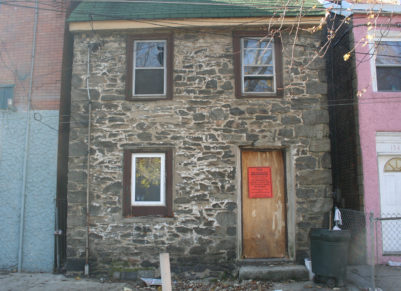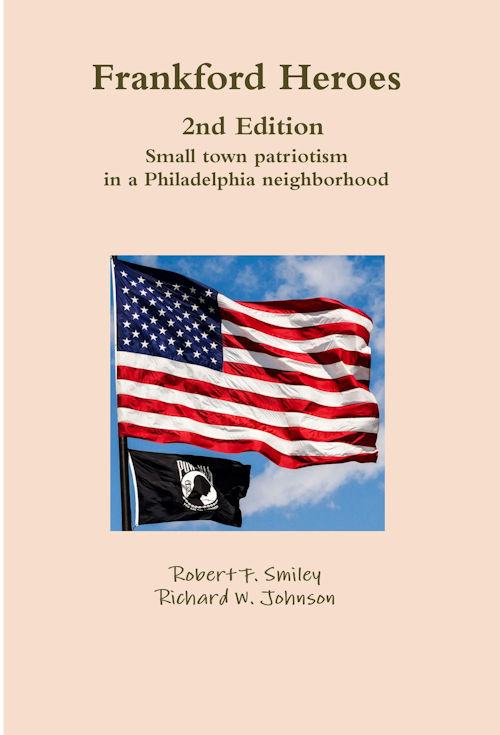The prospect of some gentrification of Frankford, with the assistance of some well-developed historical sites, here and there, makes careful preservation of buildings like 1548 Adams Avenue, the nearly-three-centuries-old Worrell/Winter house, an exciting concept.
But, Frankford and historical enthusiasts note well the following word-to-the-wise…
In the Spring of 1968, while I still lived in Frankford, I was a Sophomore in Father Judge High School up on Pennypack Creek, off Frankford Avenue. Our American History instructor was Father Leon Bonikowski.
Fr. Bonikowski loved American history with a passion. He loved historical buildings from colonial times even more. And the historical building he loved most was the Benjamin Rush house, at Red Lion Road and Keswick Road in Northeast Philadelphia. He decided to dedicate himself to personally push for reconstruction and exhibition of that colonial era structure.
One day in late 1967, Fr. Bonikowski was driving down Red Lion Road toward the intersection with Keswick Road. As he came abreast the Benjamin Rush property, he saw an astonishing sight: The Benjamin Rush house was simply gone! It had vanished!
Filled with rage, when the Spring, 1968 semester at Father Judge came around Fr. Bonikowski made, as the topic for his American History class student term papers, “What happened to the Benjamin Rush house?”
When I came home that day, and brought the subject up at the dinner table, my father fell dead quiet. This was discouraging to me, because my father was a civil engineer who was Chief of Field Operations in the Department of Licenses & Inspections in Philadelphia. If anyone could help me find the answer to the fate of the Benjamin Rush house, he could.
I nagged dad about the subject a few times more, with no result.
Finally, one night, dad brought home a file from work. He said, “Pete, I can tell you who took away the Benjamin Rush house, and show you the City’s file on it, so long as you let me review it and, if necessary, edit the your term paper, after it is completed.”
Excited, I agreed, and said, “Who took away the Benjamin Rush house?”
Dad said, “I did.”
I said, “What?????!!!!!”
Dad explained that though the Benjamin Rush house was on the Philadelphia Historical Commission’s list of premiere historical properties, the building began to fall apart, and to become an eyesore, and a gathering place for thugs. So, Licenses & Inspection boarded-up the doors and windows — exactly the way 1548 Adams Avenue is boarded-up — and put up signs, and warned the Historical Commission by certified letter that these things had been done and that building was in serious trouble.
The Historical Commission did nothing, and weather took its toll on the building.
A few years later, a portion of one of the exterior walls fell onto a child and injured him. A complaint was telephoned-in to Licenses & Inspection; my father dispatched a building inspector; and the inspector carefully examined the building and declared it “in imminent danger of collapse.”
The legally required response to that declaration was demolition. A demolition contractor was hired by the City, itself. The Benjamin Rush house was demolished. The building materials were carted-away and dumped. The basement was filled-in with fill dirt. And, suddenly, the building was no more.
My father and his boss, the Commissioner of Licenses & Inspection, read my paper and approved it, I think mostly because Licenses & Inspection had been warring with the Historical Commission for years, and they were sick of their failure to actually do something to preserve historical properties, while they protested demolition by Licenses & Inspection once the properties became a threat to life and limb.
When Fr. Bonikowski read my term paper, he was astonished to see the story, in full detail, with documentation attached, and, though my father was the actual “bad guy” who authorized destruction of the building, I received the highest grade. The paper brought Fr. Bonikowski a little peace, I think, because when he saw all of the evidence he realized that what had happened was inevitable.
You have just read the future of 1548 Adams Avenue, the nearly-three-centuries-old Worrell/Winter house, if nobody does anything, beginning now.
Peter J. Dawson
21 November 2011









